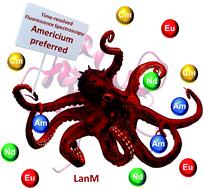当前位置:
X-MOL 学术
›
Chem. Sci.
›
论文详情
Our official English website, www.x-mol.net, welcomes your feedback! (Note: you will need to create a separate account there.)
Americium preferred: lanmodulin, a natural lanthanide-binding protein favors an actinide over lanthanides
Chemical Science ( IF 8.4 ) Pub Date : 2021-10-26 , DOI: 10.1039/d1sc04827a Helena Singer 1 , Björn Drobot 2 , Cathleen Zeymer 3 , Robin Steudtner 2 , Lena J Daumann 1
Chemical Science ( IF 8.4 ) Pub Date : 2021-10-26 , DOI: 10.1039/d1sc04827a Helena Singer 1 , Björn Drobot 2 , Cathleen Zeymer 3 , Robin Steudtner 2 , Lena J Daumann 1
Affiliation

|
The separation and recycling of lanthanides is an active area of research with a growing demand that calls for more environmentally friendly lanthanide sources. Likewise, the efficient and industrial separation of lanthanides from the minor actinides (Np, Am–Fm) is one of the key questions for closing the nuclear fuel cycle; reducing costs and increasing safety. With the advent of the field of lanthanide-dependent bacterial metabolism, bio-inspired applications are in reach. Here, we utilize the natural lanthanide chelator lanmodulin and the luminescent probes Eu3+ and Cm3+ to investigate the inter-metal competition behavior of all lanthanides (except Pm) and the major actinide plutonium as well as three minor actinides neptunium, americium and curium to lanmodulin. Using time-resolved laser-induced fluorescence spectroscopy we show that lanmodulin has the highest relative binding affinity to Nd3+ and Eu3+ among the lanthanide series. When equimolar mixtures of Cm3+ and Am3+ are added to lanmodulin, lanmodulin preferentially binds to Am3+ over Cm3+ whilst Nd3+ and Cm3+ bind with similar relative affinity. The results presented show that a natural lanthanide-binding protein can bind a major and various minor actinides with high relative affinity, paving the way to bio-inspired separation applications. In addition, an easy and versatile method was developed, using the fluorescence properties of only two elements, Eu and Cm, for inter-metal competition studies regarding lanthanides and selected actinides and their binding to biological molecules.
中文翻译:

首选镅:lanmodulin,一种天然镧系元素结合蛋白,比镧系元素更喜欢锕系元素
镧系元素的分离和回收是一个活跃的研究领域,需求不断增长,需要更环保的镧系元素来源。同样,镧系元素与次要锕系元素(Np、Am-Fm)的高效工业分离是关闭核燃料循环的关键问题之一。降低成本并提高安全性。随着依赖镧系元素的细菌代谢领域的出现,仿生应用已经触手可及。在这里,我们使用天然镧系元素螯合剂 lanmodulin 和发光探针 Eu 3+和 Cm 3+研究所有镧系元素(Pm除外)与主要锕系钚以及三种次要锕系镎、镅和锔对lanmodulin的金属间竞争行为。使用时间分辨激光诱导荧光光谱,我们表明在镧系元素中,lanmodulin 对 Nd 3+和 Eu 3+ 的相对结合亲和力最高。当将 Cm 3+和 Am 3+ 的等摩尔混合物添加到兰莫杜林时,兰莫杜林优先结合 Am 3+ 而不是 Cm 3+而 Nd 3+和 Cm 3+以相似的相对亲和力结合。呈现的结果表明,天然镧系元素结合蛋白可以以高相对亲和力结合主要和各种次要锕系元素,为仿生分离应用铺平了道路。此外,还开发了一种简单且通用的方法,仅使用两种元素 Eu 和 Cm 的荧光特性,用于镧系元素和选定锕系元素及其与生物分子结合的金属间竞争研究。
更新日期:2021-11-29
中文翻译:

首选镅:lanmodulin,一种天然镧系元素结合蛋白,比镧系元素更喜欢锕系元素
镧系元素的分离和回收是一个活跃的研究领域,需求不断增长,需要更环保的镧系元素来源。同样,镧系元素与次要锕系元素(Np、Am-Fm)的高效工业分离是关闭核燃料循环的关键问题之一。降低成本并提高安全性。随着依赖镧系元素的细菌代谢领域的出现,仿生应用已经触手可及。在这里,我们使用天然镧系元素螯合剂 lanmodulin 和发光探针 Eu 3+和 Cm 3+研究所有镧系元素(Pm除外)与主要锕系钚以及三种次要锕系镎、镅和锔对lanmodulin的金属间竞争行为。使用时间分辨激光诱导荧光光谱,我们表明在镧系元素中,lanmodulin 对 Nd 3+和 Eu 3+ 的相对结合亲和力最高。当将 Cm 3+和 Am 3+ 的等摩尔混合物添加到兰莫杜林时,兰莫杜林优先结合 Am 3+ 而不是 Cm 3+而 Nd 3+和 Cm 3+以相似的相对亲和力结合。呈现的结果表明,天然镧系元素结合蛋白可以以高相对亲和力结合主要和各种次要锕系元素,为仿生分离应用铺平了道路。此外,还开发了一种简单且通用的方法,仅使用两种元素 Eu 和 Cm 的荧光特性,用于镧系元素和选定锕系元素及其与生物分子结合的金属间竞争研究。


























 京公网安备 11010802027423号
京公网安备 11010802027423号